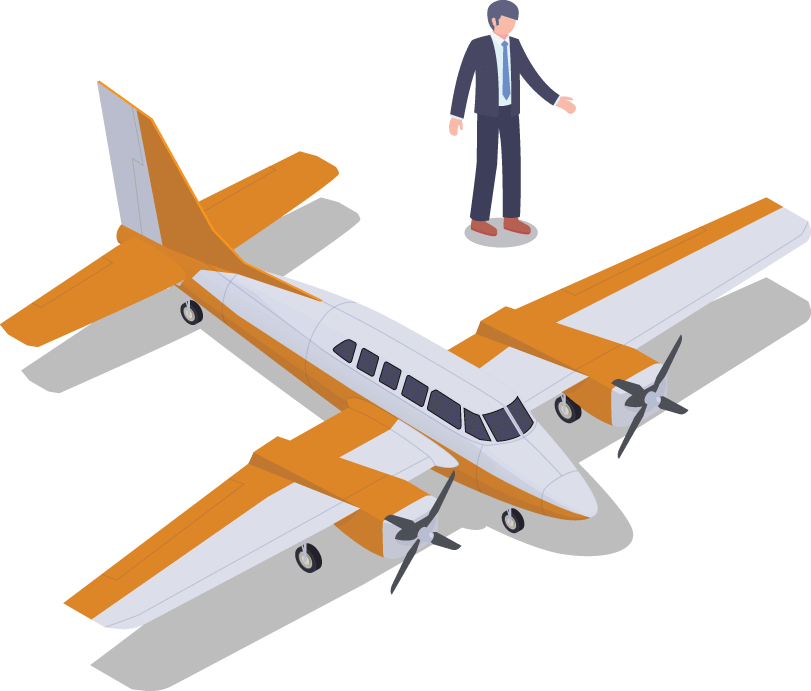It might be tempting to lump business aviation safety programs all together (“safety is safety”). However, in reality, there are some significant differences between large and small operators when it comes to promoting and implementing a robust safety culture.
“There’s a lot more variety in how small flight departments are operated,” said Joe Samudovsky, a member of NBAA’s Small Flight Department Subcommittee and flight safety officer and captain for Brandt, Inc., which has a one-aircraft, two-pilot aviation operation. “Any sort of safety tool or system needs to be scalable to the size of the small operator. If not, it might be too cumbersome for them to use.”
Samudovsky credits his chief pilot with recognizing the need to have someone solely responsible for safety.
“I did a lot of research, and we are now partnered with the Air Charter Safety Foundation. We now have an SMS, we have access to safety information and flight risk assessment tools, we have benchmarks in place, and can submit reports and have them analyzed. By collecting data, we have been able to start a more formal process to document safety risks and build benchmarks going forward.”
Samudovsky and his chief pilot also have started working with their local FSDO and are looking into eventually establishing a formal Aviation Safety Action Program. They haven’t ruled out using a Flight Operations Quality Assurance (FOQA) program, an important data benchmarking tool generally used by larger flight departments.
“Any sort of safety tool or system needs to be scalable to the size of the small operator. If not, it might be too cumbersome for them to use.”
JOE SAMUDOVSKY Flight Safety Officer and Captain, Brandt, Inc.
The Value of SOPs, Networking

Brandt’s two pilots do briefings pre- and post-flight, covering things that went both wrong and right. They have safety meetings every quarter and take recurrent training as a crew once a year.
“Since it’s just the two of us, we want to make sure that we have a mechanism in place that provides a way to objectively look at how we’re operating and identify any areas where we may be getting lax,” explained Samudovsky.
Networking with peers is also extremely important, according to Samudovsky. A larger flight department at their airport invites the two Brandt pilots to attend the larger company’s quarterly safety meetings, where they can share their experiences.
“They’ve been great,” declared Samudovsky. “Even though we may have different ways of operating, we’re still operating in the same airspace. They have a safety officer who has helped mentor me and expand my knowledge.”
“True safety culture promotes doing the right thing even when no one is watching.”
MIKE WHANNELL Chief Pilot, Jack Henry & Associates
Finally, the Brandt safety officer notes that, especially for a small operator, buy-in from the principal or CEO is key to the flight department maintaining and improving its safety.
“They are totally on board and see that we take things seriously,” said Samudovsky of his company. “We have built their trust in us.”
Personal Accountability
Mike Whannell, chief pilot for Jack Henry & Associates and a member of NBAA’s Small Flight Department Subcommittee, notes that it does not require a large group of people to achieve a higher level of professionalism.
“True safety culture promotes doing the right thing even when no one is watching,” said Whannell. “Even a single-pilot operator can develop an “IM Safe” checklist and flight risk assessment tool. It’s all about keeping yourself accountable.”
Flight data analysis tools are available and should be used whenever possible – especially by smaller operators – as a means of benchmarking their normal and abnormal flight operations against their peers for safety assurance purposes, suggested Mark Larsen, director of safety and flight operations for NBAA.
“Full-scale, FAA-approved FOQA programs may be ill-suited for many small operators, though these operators still can benefit from a review of these data analyses and work with their training providers to tailor recurrent training,” explained Larsen.
“The training companies do an amazing job,” added Whannell, “but they also need to understand the key role they play in instilling the safety culture of continuous improvement with departments of just one or two pilots.”
Also, Whannell, like Samudovsky, encourages larger flight departments to invite their smaller counterparts to company safety programs, as well as to events held by regional business aviation groups.
“We have the responsibility as industry members to regularly check in with that smaller operator, and not just have a bystander mentality. There needs to be an accountability culture by all of us,” he said.
Paul Ratté, director of aviation safety programs for USAIG and a member of NBAA’s Safety Committee, has a perspective on this topic derived from his perch in the aviation insurance sector.
“It’s easier to win trust when there are just three or four of you, but it’s harder to maintain that trust if one cog gets loose in that mechanism and throws a wrench into the whole operation.”
PAUL RATTÉ Director of Aviation Safety Programs, USAIG
“Small flight departments have an interesting clash of pros and cons,” noted Ratté.
“On the one hand, it’s easier to generate unity of purpose with a small group,” he explained.
“On the other hand, it’s easier to get set in your ways, and you get fewer opinions. It’s easier to win trust when there are just three or four of you, but it’s harder to maintain that trust if one cog gets loose in that mechanism and throws a wrench into the whole operation.”
Some sort of aggregation of safety data from similar small operators is very important for benchmarking, noted Ratté.
“People need to get over the sense that it [benchmarking] is not needed,” he said. “They [small operators] need to know, ‘Is this normal?’ It’s hard to know what’s ‘normal’ if you only look at your own operation and you fly a statistically small number of cycles.”
Pilot roundtables for smaller operators can also be very helpful, noted Ratté, who, like Whannell, also believes that regional business aviation groups should make a concerted effort to invite and include smaller flight departments in their membership.
Review NBAA’s safety resources at nbaa.org/safety.
WHEN ONE IS THE ONLY NUMBER

Jim Lara may be known to many in the business aviation community as the principal of Gray Stone Advisors, an aviation consultancy. What people may not be aware of is that he is also a one-person, one-aircraft flight department.
“We use our [Beechcraft] Baron, usually at least 15 hours a month, to respond to our client’s needs,” said Lara.
There are many such owner-pilots in the industry, and their commitment to a robust safety culture may be one of the most challenging tasks they face, since no one is looking over their shoulder.
“Your have to hold yourself accountable and responsible at all times – to your family, to the other folks in your organization, and all the people in the industry,” said Lara. “It’s all about risk mitigation.”
Lara feels that being current is just meeting the bare minimum.
“You need to be proficient and at the top of your game all the time. It’s excellence versus minimum standards, meaning that it can be expensive in terms of time and money,” noted Lara. “You need to be even more vigilant and disciplined because it’s just you.”
As a one-person flight department, Lara said that he is always making at least several decisions before he flies.
“First, am I into it? It is helpful to me to first have significant introspection. Second, I draw the line at a 12-hour duty day – and that begins the moment I start working, not just getting into the airplane. It takes me at least an hour to shift my mindset from the business side to the aviation side,” he said.
Lara keeps a black book in his Baron. After each flight, he jots down the things that did not go well.
“When I go to recurrent training, we see where patterns have developed and can use that for points of emphasis during the training. But that will only work if you are being honest.” Lara also asks his passengers for feedback after every flight.
Lara has a simple, checklist-driven SMS that he uses for every flight. “Everything needs to be standardized as much as possible,” he said.



 International Business Aviation Council Ltd.
International Business Aviation Council Ltd.